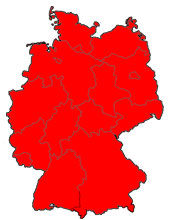Subspecies
|
No information has been entered yet.
|
Synonyms
|
Criocephalus rusticus
Arhopalus rusticus
Criocephalus tristis
Arhopalus tristis
Note: the taxon tristis has also been considered as a senior synonym of
Arhopalus ferus (and these authors then use the name Arhopalus tristis
instead of Arhopalus ferus as the valid name). However, currently the taxon tristis is
considered to be a junior synonym of Arhopalus rusticus and I therefore
list it here in the synonymy.
|
Identification
|
Quite
variable in body size; ranging between 10 and 30 mm. The color of the
elytra varies between light brown, red brown and dark brown. The
pronotum has two round depressions, and in addition often a median
furrow is also present. The present species is very similar to Arhopalus
ferus, but can be identified via eye morphology and tarsal morphology.
The eyes are equipped with tiny hairs between the ommatidia, whereas the
eyes in Arhopalus ferus are naked, but this is only visible with higher
magnification. The third segment of the hind tarsi is divided into two
lobes in both species, but in Arhopalus rusticus, the lobes are separate
almost down to the root of the segment, whereas the lobes are more
fused in Arhopalus ferus. This character can be checked more easily with
lower magnification. For jizz identification, Arhopalus ferus is the
darker species and is never light brown: light brown specimens are thus
quite certainly Arhopalus rusticus; darker specimens however have to be
carefully checked for their identity.
|
Distribution
|

A common species and recorded from all Bundesländer. However, it is more
common in the eastern part of Germany, whereas in the western part the
species appears to be declining.
Widely distributed in Europe, but absent from Ireland, Iceland, western Spain and Portugal. Also reported from northern Africa.
|
Biology
|
The
larva develops in dead or decaying trunks and roots of several species
of conifer (mainly Pinus, but also in Abies, Picea and Larix). Younger
larval stages feed superficially underneath the bark, but older larval
stages also feed deeper into the wood. The larvae may feed and develop
for several years before pupation. Pupation then takes place deep within
the tree mainly in spring or early summer and last up to three months.
Imagines eclose in the summer months (June to September) during the
night. Imagines fly in the evening or during the night. During daytime,
imagines can be found hiding underneath loose tree bark.
The species has also been recorded as a pest species of wood products
and can be accidentally introduced elsewhere with infested wood.
|
|
|
|
|

